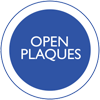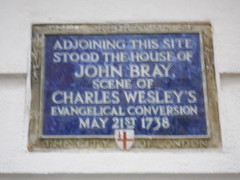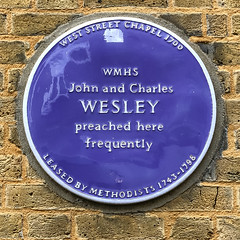Charles Wesley
Commemorated on 9 plaques
Charles Wesley 1707-1788 divine and hymn writer lived and died in a house on this site, and his sons Charles 1757-1834 and Samuel 1766-1837 musicians also lived here
1 Wheatley Street, Westminster, W1, London, United Kingdom where they lived and died (1788)
Adjoining this site stood the house of John Bray, scene of Charles Wesley's evangelical conversion May 21st 1738
13 Little Britain, EC1, London, United Kingdom where they had an evangelical conversion
The upper storey of this building was the meeting place of York Methodists from 1753 to 1759. John Wesley, Charles Wesley and George Whitefield preached here on several occasions during that time. The actual room which the Methodists occupied was destroyed by fire and replaced by the present room about the year 1880.
Newgate, York, United Kingdom where they preached
On this site John & Charles Wesley first preached in Cork and here stood the 2nd Methodist Chapel built in Ireland (1752) John Wesley made his last visit here 1789
Mercy Hospital, Grenville Place, Cork, Ireland where they preached
West Street Chapel 1700 leased by Methodists 1743-1798. WMHS John and Charles Wesley preached here frequently
26 West Street, London, United Kingdom where they preached
This tablet is erected to the glory of God in commemoration of the Evangelical Conversion of the Rev. John Wesley, M.A., on May 24, 1738. (This site of the meeting room of the Religious Society was probably 28 Aldersgate Street). And of the Rev. Charles Wesley, M.A., on May 21, 1738. The site of the house is near St Batholomew's Hospital. (No12 Little Britain). Erected by the International Methodist Historical Union. May 24 1926.
Aldersgate Street, London, United Kingdom where they was
This plaque commemorates the crossing from the ferry near the English stones during the 18th century of John and Charles Wesley Founders of Methodism on their journeys to Wales and Ireland Dedicated for the 250th anniversary of their conversion, May 28th 1988
Severn Beach, Bristol, United Kingdom where they sailed from
Some Notable People Buried Here Edward Forset Lord of the Manor 1630 Sir Edmund Douce Cupbearer to 2 Queens 1644 Dame Francis Howland 1668 Claudius de Crespigny and his wife 1695 Maria de Vierville French refugees 1708 Humphrey Wanley Librarian 1726 James Figg Pugilist 1734 James Gibbs Architect 1754 Edmond Hoyle Writer on games 1769 John Rysbrack Sculptor 1770 John Allen Royal Apothecary 1774 James Ferguson Astronomer 1776 Allan Ramsey Painter 1784 Charles Wesley Divine 1788 Stephen Storace Composer 1796 George Stubbs Painter 1806 3rd Duke of Portland Lord of the Manor 1809 Caroline Watson Engraver 1814
Garden of Rest, Marylebone High Street, London, United Kingdom where they was
Some Facts of Interest in the History of the Old Church The Church was built to replace the former Church of St John at Tyburn 1400 Francis Bacon was married here 1606 William Hogarth portrayed the interior of the Church 1735 James Gibbs Architect, pupil of Wren was buried here 1754 Richard Brinsley Sheridan married Miss Linley here 1773 Charles Wesley brother of John Wesley was buried here 1788 Lord Byron was baptized here 1788 Lord Nelson worshipped here and Horatia his only child was baptized here 1803
Garden of Rest, Marylebone High Street, London, United Kingdom where they was







.jpg?width=250)


